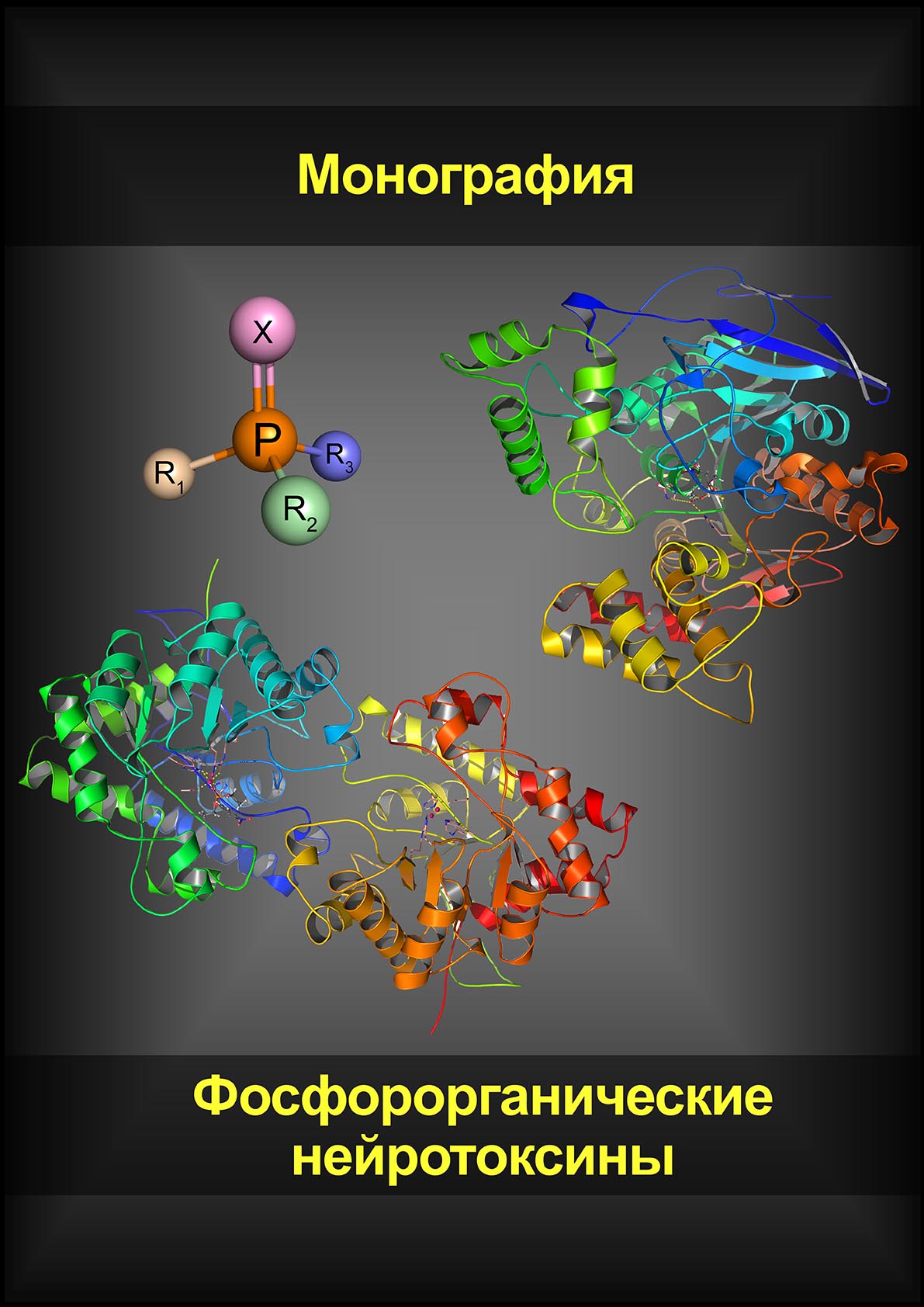Vol'sk, Saratov, Russian Federation
Vol'sk, Saratov, Russian Federation
Vol'sk, Saratov, Russian Federation
Vol'sk, Saratov, Russian Federation
Vol'sk, Saratov, Russian Federation
Vol'sk, Saratov, Russian Federation
Vol'sk, Saratov, Russian Federation
Organophosphorus compounds (OPC) occupy a special place among chemical warfare agents (CWA). High level of toxicity, a wide range of physicochemical properties, polyapplication of action already in the 1930s attracted the close attention of foreign military experts. In 1936, the German chemist Gerhard Schrader for the first time synthesized O-ethyl-dimethylamidocyanophosphate, known today as a herd. By the beginning of the Second World War, the staff of his laboratory synthesized over two thousand new OPC. Some of these compounds were selected for further study as CW agents and subsequently were adopted as weapons by the German army. In 1938 the same Gerhard Schrader have synthesized the organophosphorus compound, closed to tabun, but more toxic: O-isopropyl methyl fluorophosphate, called sarin. In 1944 the German chemist, the 1938 Nobel laureate in chemistry Richard Kuhn synthesized soman and revealed the damaging effect of organophosphorus CWA’s. In 1941 the British chemist Bernard Saunders synthesized diisopropyl fluorophosphate. During World War II the industrial production of organophosphorus CWA’s was organized in Germany, Great Britain and in the USA. Germany produced tabun, sarin and soman, the western allies: diisopropyl fluorophosphate. Till the end of World War II the leadership in the sphere of the development of nerve agents belonged to Nazi Germany. After the end of the war the German scientists, many of whom were devoted Nazis, continued their work under the auspices of military departments of the USA and Great Britain. Subsequently phosphorylated thiocholine esters: V-series substances (VG, VM, VR, VX, EA 3148, EA3317 agents etc.) were synthesized with their participation. The wide range of organophosphorus compounds was tested on volunteers in Porton Down (Great Britain) and in the Edgewood arsenal (USA). But after the synthesis of V-series agents the work on organophosphorus CWA’s did not stop. In recent years there appeared the tendency of the transformation of real threats connected with the chemical weapons use, to propaganda sphere. In recent years, there has been a tendency toward the transformation of real threats associated with the use of chemical weapons into provocation and an advocacy field, but this does not mean that the search for new CWA in Western countries has been stopped.
bicyclophosphates, GV-series substances, G-series substances, V-series substances, substance “A-234”, toxic substances of nerve agent, Porton Down, phosphorylated thiocholine esters, organophosphorus poisonous substances, chemical weapon, Edgewood Arsenal, experiments on volunteers
1. Aslanli A.G., Stepanov N.A., Senko O.V., Maslova O.V., Lyagin I.V., Efremenko E.N. The hexahistidine containing organophosphorus hydrolase enzyme and bacterial cellulose based functional materials. In IOP Conference Series: Materials Science and Engineering, 2019, 525 (1). P. 012005. IOP Publishing.
2. Aslanly A.G., Maslova O.V., Sen'ko O.V., Efremenko E.N. Polifunkcional'nyy fermentnyy biopreparat na osnove geksagistidinsoderzhaschey organofosfatgidrolazy, deystvuyuschiy protiv bakterioza rasteniy. Vestnik biotehnologii i fiziko-himicheskoy biologii imeni Yu.A. Ovchinnikova, 2017, 13. S. 13-17.
3. Aslanli A., Lyagin I., Efremenko E. Charges' interaction in polyelectrolyte (nano)complexing of His6-OPH with peptides: unpredictable results due to imperfect or useless concept? Int. J. Biol. Macromol., 2019, 140. Pp. 368–376.
4. Boroduleva A.Y., Wu J., Yang Q., Li H., Zhang Q., Li P., Eremin. S.A. Development of fluorescence polarization immunoassays for parallel detection of pesticides carbaryl and triazophos in wheat grains. Anal. Methods, 2017, 9 (48). Pp. 6814–6822.
5. Bravaya K.B., Bochenkova A.V., Grigorenko B.L., Topol I.A., Burt S.K., Nemukhin A.V. Molecular modeling the reaction mechanism of serine-carboxyl peptidases. J. Chem. Theory Comput., 2006, 2. Pp. 1168–1175.
6. Carletti E.N., Colletier J.-P., Dupeux F., Trovaslet M., Masson P., Nachon F. Structural evidence that human acetylcholinesterase inhibited by tabun ages through O-dealkylation. J Med Chem, 2010, 53. Pp. 4002–4008.
7. Grigorenko B.L., Novichkova D.A., Lushchekina S.V., Zueva I.V., Schopfer L.M., Nemukhin A.V., Varfolomeev S.D., Lockridge O., Masson P. Computer-designed active human butyrylcholinesterase double mutant with a new catalytic triad, Chem.-Biol. Interact., 2019, 306. Pp. 138–146.
8. Gudkov D.A., Lyagin I.V., Efremenko E.N., Kabanov A.V. Effect of dimerization on the catalytic properties of native and chimeric organophosphorus hydrolase determined by molecular modeling of the enzyme structure. Russian Chemical Bulletin, 2012, 1 (2), Pp. 449–455.
9. Gudkov D.A., Lyagin I.V., Verkhusha V.V., Efremenko E.N. Hybrid proteins with organophosphorus hydrolase activity and fluorescence of deGFP4 protein. Moscow University Chemistry Bulletin, 2011, 66 (2). Pp. 92–98.
10. Efremenko E., Lyagin I., Gudkov D., Varfolomeyev S. Immobilized biocatalysts for detoxification of neurotoxic organophosphorous compounds. Biocatalysis and Biotransformation, 2007, 25 (2–4). Pp. 359–364.
11. Efremenko E.N., Sen'ko O.V., Kuc V.V., Alenina K.A., Holstov A.V., Ismailov A.D. Lyuminescentnyy biokatalizator dlya opredeleniya toksikantov. Patent RF na izobretenie № 2394910, 2010.
12. Efremenko E.N., Zav'yalova N.V., Lyagin I.V., Sen'ko O.V., Gudkov D.A., Aksenov A. V., Stepanov N.A., Sirotkina M.S., Spiricheva O.V., Ivanov R.V., Lozinskiy V.I., Varfolomeev S.D., Kondrat'ev V.B., Holstov V.I. Sposob biorazlozheniya fosfororganicheskih soedineniy v sostave reakcionnyh mass, poluchaemyh posle himicheskogo unichtozheniya veschestva tipa VX. Patent RF na izobretenie № 2408724, 2009.
13. Eremenko A.V., Prokopkina T.A., Kasatkin V.E., Osipova T.A., Kurochkin I.N. Planarnye tiol-chuvstvitel'nye sensornye elementy dlya opredeleniya aktivnosti butirilholine¬sterazy i analiza ee ingibitorov. Vestnik Moskovskogo Universiteta. Seriya 2. Himiya, 2014, 55 (3). S. 174–179.
14. Efremenko E.N., Lyagin I.V., Klyachko N.L., Bronich T., Zavyalova N.V., Jiang Y., Kabanov A.V. A simple and highly effective catalytic nanozyme scavenger for organophosphorus neurotoxins. J. Control. Release, 2017, 247. Pp. 175–181.
15. Efremenko E.N., Lyagin I.V., Zav'yalov V.V., Zav'yalova N.V., Holstov V.I., Yankovskaya A.A. Razryv S-R svyazi v fosfonatah pod deystviem fermentnyh biokatalizatorov. Teoreticheskaya i prikladnaya ekologiya, 2015, 3. C. 47–54
16. Efremenko E.N., Lyagin I.V., Gudkov D.A., Stepanov N.A., Sen'ko O.V., Maslova O.V., Kovalev D.A., Zav'yalova N.V., Holstov V.I., Yankovskaya A.A. Kombinirovannoe primenenie fermentnogo i bakterial'nogo biokatalizatorov v processah biodestrukcii FOV i produktov ih razlozheniya. Teoreticheskaya i prikladnaya ekologiya, 2015, (3). S. 35–39.
17. Eremenko A.V., Dontsova E.A., Nazarov A.P., Evtushenko E.G., Amitonov S.V., Savilov S.V., Martynova L.F., Lunin V.V., Kurochkin I.N. Manganese Dioxide Nanostructures as a Nov¬el Electrochemical Mediator for Thiol Sensors. Electroanalysis, 2012, 3. P. 573.
18. Ermakova I.T., Shushkova T.V., Sviridov A.V., Zelenkova N.F., Vinokurova N.G., Baskunov B.P., Leontievsky A.A. Organophosphonates utilization by soil strains of Ochrobactrum anthropi and Achromobacter sp. Arch. Microbiol., 2017, 199(5). Pp. 665–675.
19. Filimonov I.V., Yankovskaya A.A., Kuzhelko S.V., Zav'yalov V.V., Zav'yalova N.V., Golipad A.N., Kolesnikov D.P., Kovtun V.A., Holstov V.I., Lyagin I.V., Efremenko E.N. Issledovaniya v sfere perspektivnogo ispol'zovaniya himiko-biologicheskih i medicinskih biokataliticheskih tehnologiy v interesah Vooruzhennyh Sil. Vestnik voysk RHB zaschity, 2018, 2 (2). S. 18–50.
20. Hua X., Eremin S.A., Liu F., Wang M. Antibody Developments and Immunoassays for Organophosphorus Chemicals: A Review. Current Organic Chemistry, 2017, 21 (26). Pp. 2640–2652.
21. Liu Y., Liu R., Boroduleva A., Eremin S., Guo Y., Zhu G. A highly specific and sensitive fluorescence polarization immunoassay for the rapid detection of triazophos residue in agricultural products. Anal. Methods, 2016, 8 (36). Pp. 6636–6644.
22. Lyagin I.V., Efremenko E.N., Varfolomeev S.D. Fermentnye biosensory dlya opredeleniya pesticidov. Uspehi himii, 2017, 86. Pp. 339–355.
23. Lyagin I., Efremenko E. Theoretical evaluation of suspected enzymatic hydrolysis of Novichok agents. Catal. Commun., 2019, 120. Pp. 91–94.
24. Lyagin I.V., Andrianova M.S., Efremenko E.N. Extensive hydrolysis of phosphonates as unexpected behaviour of the known His6-organophosphorus hydrolase. Appl. Microbiol. Biotechnol., 2016, 100. Pp. 5829–5838.
25. Lyagin I., Efremenko E. Enzymes for Detoxification of Various Mycotoxins: Origins and Mechanisms of Catalytic Action. Molecules, 2019, 24. e2362, doi: 10.3390/molecules24132362.
26. Lushchekina S.V., Schopfer L.M., Grigorenko B.L., Nemukhin A.V., Varfolomeev S.D., Lockridge O., Masson P. Optimization of Cholinesterase-Based Catalytic Bioscavengers Against Organophosphorus Agents, Front. Pharmacol., 2018, 9. P. 211.
27. Makhaeva G.F., Rudakova E.V., Serebryakova O.G., Aksinenko A.Y., Lushchekina S.V., Bachurin S.O., Richardson R.J. Esterase profiles of organophosphorus compounds in vitro predict their behavior in vivo, Chem.-Biol. Interact., 2016, 259 (Pt B). Pp. 332–342.
28. Maslova O.V., Stepanov N.A., Grigoryeva A.I., Bruyako M.G., Efremenko E.N. New effective His6-OPH-containing mineral carriers pretreated by low-temperature plasma for destruction of organophosphates in different types of soil. International Journal of Pharmacy & Technology, 2016, 8. Pp. 27317–27333.
29. Maslova O., Aslanli A., Stepanov N., Lyagin I., Efremenko E. Catalytic characteristics of new antibacterials based on hexahistidine-containing organophosphorus hydrolase. Catalysts, 2017, 7 (9). P. 271.
30. Maslova O.V., Senko O.V., Stepanov N.A., Aslanli A.G.Q., Efremenko E.N. His6-OPH and its stabilized forms combating quorum sensing molecules of gram-negative bacteria in combination with antibiotics. Jundishapur J. Nat. Pharm. Prod., 2017, 12 (3). P. e63649.
31. Maslova O.V., Aslanly A.G., Sen'ko O.V., Efremenko E.N. Vozmozhnosti snizheniya minimal'nyh ingibiruyuschih koncentraciy puromicina i ceftiofura pri ih sochetanii s biopreparatami na osnove His6-OPH. Vestnik Moskovskogo universiteta. Seriya 2 Himiya, 2018, 59. S. 439–444.
32. Masson P., Nachon F., Broomfield C.A. et al. A collaborative endeavor to design cholinesterase-based catalytic scavengers against toxic organophosphorus esters. Chem. Biol. Interact., 175 (2008). Pp. 273–280.
33. Masson P., Nachon F. Cholinesterase reactivators and bioscavengers for pre- and post-exposure treatments of organophosphorus poisoning, J. Neurochem., 2017, 142 Suppl 2. Pp. 26–40.
34. Mehta J., Dhaka S., Paul A.K., Dayananda S., Deep A. Organophosphate hydrolase conjugated UiO-66-NH2 MOF based highly sensitive optical detection of methyl parathion. Environ. Res., 2019, 174. Pp. 46–53.
35. Moralev S.N., Rozengart E.V. Comparative Enzymology of Cholinesterases, IUL Biotechnology Series La Jolla, CA (2007). 484 p.
36. Nechaeva N., Prokopkina T., Makhaeva G., Rudakova E., Boltneva N., Dishovsky C., Ere¬menko A., Kurochkin I. Quantitative butyryl¬cholinesterase activity detection by surface-en-hanced Raman spectroscopy. Sensors and Actu¬ators B., 2018, 259. Pp. 75–82.
37. Nel'ga I.A., Medveckiy I.V., Zlobin A.V., Tre¬t'yakov S.V., Sherstyuk A.V., Kostyuchenko I.V. Himicheskoe oruzhie: istoriya issledovaniya fosfororganicheskih otravlyayuschih veschestv za rubezhom. Vestnik voysk RHB zaschity, 2019, 3 (2). S. 175–193.
38. Nemukhin A.V., Lushchekina S.V., Bochenkova A.V., Golubeva A.A., Varfolomeev S.D. Characterization of a complete cycle of acetylcholinesterase catalysis by ab initio QM/MM modeling. J. Mol. Model., 2008, 14. Pp. 409–416.
39. Supotnickiy M.V., Shilo N.I., Kovtun V.A. Himicheskoe oruzhie v irano-irakskoy voyne 1980–1988 godov. 1. Podgotovka Iraka k himicheskoy voyne. Vestnik voysk RHB zaschity, 2019, 1 (3). S. 40–64.
40. Shushkova T.V., Vinokurova N.G., Baskunov B.P., Zelenkova N.F., Sviridov A.V., Ermakova I.T., Leontievsky A.A. Glyphosate acetylation as a specific trait of Achromobacter sp. Kg 16 physiology. Appl. Microbiol. Biotechnol., 2016, 100. Pp. 847–855.
41. Senko O., Gladchenko M., Maslova O., Efremenko E. Long-term storage and use of artificially immobilized anaerobic sludge as a powerful biocatalyst for conversion of various wastes including those containing xenobiotics to biogas. Catalysts, 2019, 9. P. e326, DOI: 10.3390/catal9040326.
42. Senko O., Stepanov N., Tyutyunov A., Sterlin S., Grinberg V., Makhlis T., Efremenko E. Intensification of organophosphorus hydrolase synthesis by using substances with gas-transport function. Appl. Sci., 2017, 7. P. e1305, DOI: 10.3390/app7121305.
43. Senko O., Maslova O., Efremenko E. Optimization of the use of His6-OPH-based enzymatic biocatalysts for the destruction of chlorpyrifos in soil. International journal of environmental research and public health, 2017, 14 (12). P. 1438.
44. Sviridov A.V., Shushkova T.V., Ermakova I.T., Ivanova E.V., Epiktetov D.O., Leontievsky A.A. Microbial degradation of glyphosate herbicides (Review). Appl. Biochem. Microbiol., 2015, 51 (2). Pp. 188–195.
45. Varfolomeev S.D., Semenova N.A., Bykov V.I., Cybenova S.B. Kinetika himicheskih processov v mozge cheloveka. Modelirovanie BOLD-signala pri fMRT issledovanii. Doklady AN, 2019, 488 (2). S. 39–43.
46. Varfolomeev S.D., Semenova N.A., Ublinskiy M.V., Bykov V.I., Tsybenova S.B. fMRI and MR-spectroscopy in research on triggering and autostabilization of N-acetylaspartate. Chemical Physics Letters, 2019, 729. Pp. 84–91.
47. Wang P., Li H., Hassan M.M., Guo Z., Zhang Z.Z., Chen Q. Fabricating an Acetylcholinesterase Modulated UCNPs-Cu2+ Fluorescence Biosensor for Ultrasensitive Detection of Organophosphorus Pesticides-Diazinon in Food. J. Agric. Food Chem., 2019, 67. Pp. 4071–4079.
48. Zav'yalov V.V., Kuzhelko S.V., Zav'yalova N.V., Kovtun V.A., Holstov V.I., Taranchenko Yu.F., Slastilova L.M., Efremenko E.N., Sen'kilev A.P. Sovremennye napravleniya sozdaniya novyh zaschitnyh materialov i tkaney dlya sredstv individual'noy i kollektivnoy zaschity ot toksichnyh himikatov i kletok patogenov. Vestnik voysk RHB zaschity, 2019, 3 (3). S. 117–148.
49. Zhang H., Yang S., Ruyck K.D., Beloglazova N., Eremin S.A., Saeger S.D., Zhang S., Shen J., Wang Z. Fluorescence polarization assays for chemical contaminants in food and environmental analyses. Trends in Anal. Chem., 2019, 114. Pp. 293–313.





